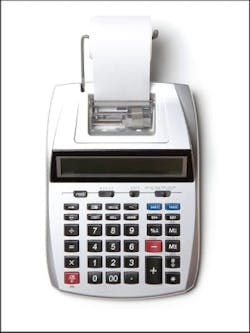Jack Crawley can laugh it off now, but he doesn’t prefer to think about his old pricing methods. When he took over ownership of Fisk Automotive in Fullerton, Calif., in 2000, Crawley fell into the pricing structure used by the vast majority of shops across the country.
That is to say, he didn’t have much of one.
“Just kind of went by the seat of my pants,” he says.
Crawley says he used labor rates and price markups that seemed to be standard in the industry, or at least common in the shop where he had experience. He paid close attention to the prices of competitors. He picked a labor rate. He picked a percentage to mark up parts. And all he could do was hope it would work.
“The reality was, I just didn’t know a better way to do it,” he says.
But, as Crawley came to realize, there is a better way to do it, and it comes down to three simple letters: P.I.F.
Profit Index Factor.
Developed and patented by former shop owner Scott Johnson for his ProfitBoost Software shop management system, P.I.F. refers to the dollar amount a shop needs to make on every sold job in order to cover overhead, parts, labor, and, maybe most importantly, desired profit.
In its simplest form, this formula tells shop owners how to set their prices to meet the specific needs of their businesses.
“Essentially, 99 percent of shops set prices on a whim,” Johnson says. “There is no metric, there’s no forethought, and there is no plan to see if the job is worth doing. The Profit Index Factor solves that problem.”
What’s wrong with this picture?
Industry consultant and former shop owner Thom Tschetter says there’s a simple equation most shops currently use for pricing: labor rate multiplied by repair time, plus the price of marked-up parts.
Can you see what’s missing from this formula?
That’s right: The needs of your business.
“The problem is that people just fell into this model,” Tschetter says. “And, when it’s worked, it’s simply by coincidence.”
That is slowly changing, though, he says. Overhead in shops has increased in recent years, and simply having a 50-50 labor-to-parts split in pricing or taking a peek at a shop’s window sign down the street won’t work anymore.
“When I say overhead, I include all your shop’s fixed costs, as well as variable costs,” he says. “Those items have increased so much. Before [P.I.F.], the industry has never really had a good pricing model that has allowed shops to recapture those costs on a per-hour basis.”
Without a specific, tangible formula for picking prices, Tschetter says, it’s just the “blind leading the blind.”
Personalize your prices: How P.I.F. works
Johnson’s ProfitBoost software automatically calculates the P.I.F. number for shops. Although it’s a slightly complicated formula, Johnson says repairers can still figure it out with an old-fashioned mix of pencil, paper and calculator—and a whole lot of information about your business, of course.
“The P.I.F. number will vary from shop to shop,” he says. “There is no one-size-fits-all model. That’s what’s wrong with our industry: Most consultants suggest just simply marking up parts prices by a certain percentage.”
While it’s important to keep your prices competitive, the reality is, Johnson says, the only two things that matter when setting a price are expenses and adjusted capacity.
Expenses. Johnson’s model is built on numbers for an entire fiscal year, thus averaging both slow and heavy stretches of sales. So, the first step is adding up all of your expenses for a fiscal year. This includes all fixed costs of your business—all bills, salaries (including your own as owner), taxes, fees, technology purchases, etc. Everything your business spends money on during the year needs to be accounted for. And then, he says, add in your “desired” profit for the year. The total number makes up your “expenses” portion of the equation.
Adjusted capacity. Every shop has a “capacity” to the amount of work it can produce, and this is dependent on the number of employees you have and their production outputs. Essentially, what you are looking for is your technicians’ total billable hours for the entire fiscal year. Let’s say, for example, your shop is open 52 weeks a year and your techs work 40 hours each week, Johnson explains. That’s 2,080 hours, but you have to take into account vacation days, sick days and morning and afternoon breaks. Maybe, Johnson says, that comes back down to 1,600 hours each year.
From that, if your technician is only 60 percent productive (meaning 60 percent of his hours are actually billed to customers), then you really have 1,200 hours worked for the year. A shop owner needs to find this number for each technician. All their numbers added together equates to the shop’s overall adjusted capacity.
Simple math. Now comes the easy part: To find your P.I.F. number—the dollar amount your shop needs from every sale in order to be successful—you simply divide your expenses by the adjusted capacity.
Quick example
If a shop has two technicians, working at the aforementioned 60 percent productivity level, then the shop’s adjusted capacity is 2,400 billable hours. Now, let’s say that shop added up its total expenses, including its desired profit. Say it came to $300,000 for a fiscal year. The shop will get a P.I.F. number of $125 (300,000/2,400).
How to apply it to your pricing
Once a shop has its P.I.F. number, then it can formulate its pricing structure. Both Johnson and Tschetter say a shop should use its P.I.F. number—and the shop’s current numbers of sales and gross profits on parts—to determine both labor rates and parts mark-ups.
For instance, Johnson says a shop with a P.I.F. of $125 may decide to keep a fairly standard labor rate of $80 or $90, and then understand that it needs to make up at least $35 in parts for each hour of service it sells. Shops with a higher number need to increase both those areas; shops with a lower P.I.F. need to decrease those numbers.
Of course, there are always instances where a job simply can’t reach those types of numbers, like an oil change for instance. Tschetter says you should do those jobs with “your eyes open.”
“It’s OK to do a job as long as there is gross profit,” he says. “You just don’t want to do a job with too low of gross profit when you have cars lined up in the parking lot.”
Crawley, who often gets service-oriented jobs in his California shop, says the best way to make up for those low-paying jobs is through car count and greater efficiency.
“An oil change should never take an hour of a tech’s time, and we don’t charge a full hour for the service,” he says. “If your techs are highly productive, then that oil change winds up being just added revenue.”
Check, check, and then recheck
Markets change. Businesses change. Some employees may quit; some may be added to the staff. There are always things to account for in a business, and that’s why Crawley says he checks his P.I.F. number frequently.
“The best recommendation is to check it monthly,” he says. “Look at your budget, look at your hours and see where you’re at. Then, you can make any adjustments you may need to make. Maybe it’s as simple as altering your parts margin just a bit to make up for a slow month.
“When you have things like a staff change, it doesn’t just throw it into a tizzy, but it’s something you have to adjust for as far as pricing goes,” he says. “You’ve added another person, which accounts for more overhead, more vacation time, all of that is calculated into your P.I.F. number, and it helps you to stay profitable throughout the year.”
Mainly, Crawley says, the P.I.F. number gives him a way to be fully aware of and fully confident in how he prices each job that comes into his shop. Without it, he says, his shop would just be taking a shot in the dark. You know, like most everyone else.
“Anyone that’s serious about their business needs to set goals and understand where they’re at on a regular basis,” he says. “If you don’t know the right goals to set or how to get there, then you’re lost before you even started.”



